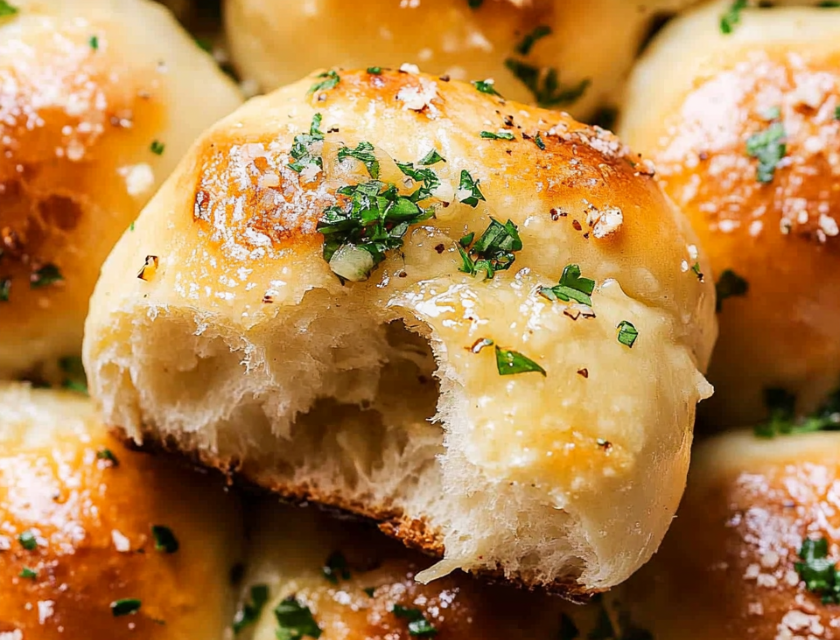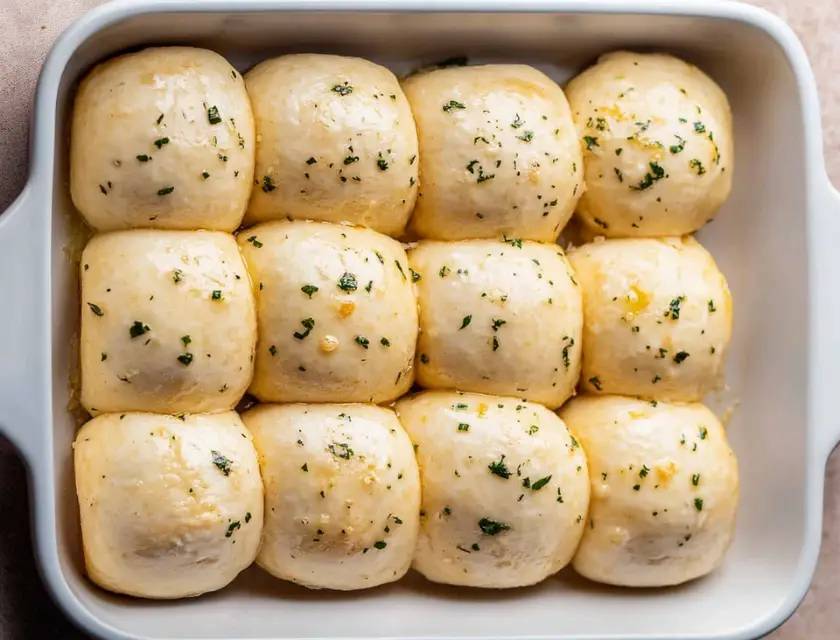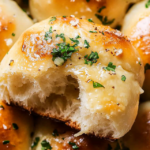Garlic bread rolls are a delightful addition to any meal. Whether you’re hosting a dinner party, preparing a festive holiday feast, or simply looking for the perfect accompaniment to a cozy bowl of soup, these soft, buttery rolls bring flavor and warmth to your table. With their golden crust brushed with fragrant garlic butter and a soft, fluffy interior, these rolls are irresistibly delicious.

This recipe for garlic bread rolls offers a balance of indulgence and simplicity. It’s approachable for novice bakers yet satisfying for seasoned cooks. From the rich garlic butter topping to the perfectly proofed dough, this guide will help you create rolls that are as enjoyable to bake as they are to eat.
Overview of Garlic Bread Rolls
Garlic bread rolls are a variation of classic dinner rolls, enriched with garlic butter and fresh parsley for an added burst of flavor. These rolls are the perfect marriage of texture and taste, combining the fluffy tenderness of homemade bread with the savory richness of garlic and butter.
What sets garlic bread rolls apart from other bread recipes is the unique garlic butter topping. When brushed over the hot rolls straight out of the oven, the garlic butter seeps into the crust, enhancing the flavor and creating a glossy finish. The addition of flaky sea salt on top adds a subtle crunch and a touch of sophistication.
These rolls are versatile and can be served alongside pasta, soups, salads, or even enjoyed on their own. Their aroma while baking is enough to fill your home with a sense of comfort and anticipation.
Brief History and Cultural Significance
The history of garlic bread rolls can be traced back to the origins of garlic bread itself. Garlic bread, often associated with Italian-American cuisine, is believed to have evolved from the Italian bruschetta – slices of toasted bread rubbed with garlic and drizzled with olive oil. Over time, this tradition merged with the American preference for soft, buttery bread rolls, leading to the creation of garlic bread rolls.
In Italy, bread has long been a staple food, and garlic is a widely used ingredient, celebrated for its bold flavor and health benefits. When Italian immigrants introduced their cuisine to the United States, garlic bread became a popular adaptation, and soon, variations like garlic bread rolls emerged.
Today, garlic bread rolls hold a special place in many cultures as a comforting and flavorful accompaniment. They are commonly featured at family dinners, holiday gatherings, and special occasions, symbolizing warmth and togetherness.
Preparation Phase & Tools to Use
Essential Tools and Equipment
To create perfect garlic bread rolls, you’ll need the following tools:
- 9×13 baking pan: This size ensures even baking and allows the rolls to snugly fit together.
- Stand mixer with a dough hook attachment: A stand mixer makes kneading the dough effortless, especially for beginners.
- Kitchen scale: Precise measurement of ingredients, especially flour, is critical for achieving the right dough consistency.
- Pastry brush: Essential for brushing the garlic butter and egg wash over the rolls.
- Measuring cups and spoons: Properly measuring both wet and dry ingredients is crucial to the success of this recipe.
- Small saucepan: Used to prepare the garlic butter.
These tools are key to achieving consistent results and making the baking process as smooth as possible. If you don’t have a stand mixer, you can knead the dough by hand, though it will require more effort.
Preparation Tips
Measuring Ingredients Correctly
Accurate measurement is one of the most critical steps in baking. Use the spoon-and-level method for measuring flour to avoid overpacking, which can result in dense rolls. For the best results, invest in a kitchen scale to measure ingredients by weight.
Handling Yeast
Yeast is a living organism and highly sensitive to temperature. Ensure the milk is warmed to about 110°F—warm enough to activate the yeast but not so hot that it kills it. If using active dry yeast instead of instant yeast, you’ll need to activate it first by dissolving it in warm milk with a sprinkle of sugar. Let it sit for about five minutes until foamy.
Proofing Dough
Proofing is a critical step that allows the dough to rise and develop its structure. Choose a warm, draft-free spot in your kitchen for proofing. Cover the dough with plastic wrap or a clean kitchen towel to prevent it from drying out.
Ingredients List
For the Dough
- 4 1/2 tablespoons unsalted butter
- 2 tablespoons minced garlic
- 3 1/2 cups + 1 tablespoon all-purpose flour (measured correctly for accuracy)
- 3 tablespoons chopped fresh parsley
- 1 tablespoon granulated sugar
- 2 1/4 teaspoons instant yeast
- 1 teaspoon fine sea salt
- 1 cup whole or 2% milk (warmed to 110°F)
- 1 large egg (room temperature)
For Brushing
- 1 beaten egg (for brushing the tops before baking)
For the Garlic Butter Topping
- 2 tablespoons unsalted butter
- 1 tablespoon minced garlic
- 1 tablespoon chopped fresh parsley
- Flaky sea salt (optional, for finishing)
Step-by-Step Instructions
Step 1: Prepare Your Baking Pan
Preheat the oven to 350°F (180°C). Lightly butter the bottom and sides of a 9×13 baking pan. Set it aside while you prepare the dough.
Step 2: Make the Garlic Butter
In a small saucepan, melt the butter over medium heat. Add the minced garlic and cook for 1–2 minutes until fragrant. Remove the pan from the heat and set the garlic butter aside to cool.
Step 3: Mix the Dry Ingredients
In the bowl of a stand mixer, combine the flour, parsley, sugar, yeast, and salt. Use a whisk to mix the ingredients evenly.
Step 4: Add Wet Ingredients
To the dry mixture, add the warmed milk, egg, and the cooled garlic butter. Use the dough hook attachment on the stand mixer to knead the dough on low speed. Knead for 10–12 minutes until the dough is smooth and slightly tacky to the touch. If the dough is too sticky, add one tablespoon of flour at a time until it becomes workable.

Step 5: Divide and Shape the Dough
Turn the dough out onto a lightly floured surface. Use a kitchen scale to divide the dough into 12 equal portions (approximately 67 grams each). Shape each portion into a smooth ball by rolling it under your palm. Pinch the bottom of each ball where the seam comes together to ensure a tight roll.
Step 6: Arrange and Proof the Rolls
Place the dough balls into the prepared baking pan, arranging them in a snug but even formation. Cover the pan with plastic wrap or a clean kitchen towel. Allow the rolls to proof in a warm place until they double in size. This process can take 1–2 hours depending on the temperature of your kitchen.
Step 7: Brush and Bake
Once the rolls have risen, lightly brush the tops with the beaten egg wash. Bake in the preheated oven for 20–30 minutes, or until the tops are golden brown.
Step 8: Prepare the Garlic Butter Topping
While the rolls are baking, prepare the topping by melting butter in a small saucepan. Add the minced garlic and cook for 1–2 minutes until fragrant. Remove from heat and stir in the chopped parsley.
Step 9: Add the Finishing Touches
When the rolls come out of the oven, immediately brush them with the prepared garlic butter. Sprinkle with flaky sea salt if desired. Serve the rolls warm for the best flavor and texture.
Side Dish Recommendations
Garlic bread rolls are incredibly versatile and pair well with a wide variety of dishes. Their soft, fluffy texture and buttery garlic flavor make them the perfect accompaniment to both hearty and light meals. Below are some of the best pairings to elevate your dining experience:
Classic Italian Dishes
Garlic bread rolls are a natural fit with Italian cuisine. They complement tomato-based dishes, cheesy bakes, and rich, savory flavors.
- Spaghetti Bolognese: The garlic bread rolls can soak up the rich meat sauce, providing the perfect balance of carbs and protein.
- Lasagna: Layered with cheese, pasta, and sauce, lasagna is made even better with a buttery roll to cut through the richness.
- Chicken Parmesan: The crispy, cheesy chicken paired with garlic rolls is a match made in heaven.
Soups and Stews
Dipping garlic bread rolls into warm soups or stews is a comforting way to enjoy them. The bread absorbs the broth while adding a garlicky twist.
- Tomato Basil Soup: The acidity of the tomatoes is balanced beautifully by the buttery, garlicky rolls.
- Minestrone: The heartiness of the vegetable soup is enhanced by the soft texture of the rolls.
- Beef Stew: Perfect for soaking up the savory juices of this slow-cooked classic.
Light Salads
Pairing garlic bread rolls with fresh salads creates a contrast of textures and flavors.
- Caesar Salad: The crisp romaine lettuce, creamy dressing, and crunchy croutons pair well with the softness of garlic rolls.
- Greek Salad: The tangy feta and olives complement the rolls’ savory, buttery notes.
- Arugula and Parmesan Salad: The peppery arugula and sharp Parmesan balance the richness of the rolls.
Hearty Mains
Garlic bread rolls can also serve as a side dish for heavier mains, adding a complementary layer of flavor.
- Grilled Steak: The smoky, meaty flavors of steak pair perfectly with the garlicky warmth of the rolls.
- Roast Chicken: A classic roast chicken dinner is made even better with the addition of fresh, warm rolls.
- Herb-Crusted Salmon: The savory herb crust on the salmon aligns beautifully with the parsley in the garlic butter.
Dips and Spreads
Garlic bread rolls can double as a vehicle for flavorful dips and spreads.
- Spinach Artichoke Dip: The soft rolls are ideal for scooping up this creamy, cheesy dip.
- Marinara Sauce: The rolls serve as a perfect dipping option for a tangy marinara sauce.
- Hummus: For a lighter option, pair the rolls with roasted garlic or lemon hummus.
Holiday Pairings
These rolls also shine on festive tables as they pair well with holiday classics:
- Thanksgiving Turkey: Use the rolls to make miniature turkey sandwiches with cranberry sauce.
- Christmas Ham: The garlic and parsley flavor of the rolls pairs wonderfully with the sweetness of glazed ham.
Nutritional Information and Health Benefits
While garlic bread rolls are a treat, understanding their nutritional profile can help you enjoy them in moderation. Below is a general overview of their nutritional composition:
Caloric Breakdown
- Each roll contains approximately 150–200 calories, depending on size and the amount of butter used.
- Calories come primarily from carbohydrates in the flour and fat from the butter.
Macronutrients
- Carbohydrates: These rolls are rich in carbohydrates, providing a quick source of energy.
- Proteins: The egg and milk in the dough contribute a small amount of protein.
- Fats: Butter is the primary source of fat, adding richness and flavor to the rolls.
Vitamins and Minerals
- Garlic: Contains vitamins B6 and C and manganese. It also has antioxidant properties and potential cardiovascular benefits.
- Parsley: A source of vitamins A, C, and K, as well as iron and folate.
- Milk: Provides calcium, vitamin D, and other essential nutrients.
Health Benefits of Key Ingredients
- Garlic: Known for its immune-boosting and anti-inflammatory properties. It also helps regulate blood pressure and cholesterol levels.
- Parsley: Contains antioxidants and promotes healthy digestion.
- Butter: When consumed in moderation, it adds necessary fats for energy and flavor.
Balancing Indulgence
While garlic bread rolls are undoubtedly indulgent, they can fit into a balanced diet when paired with nutrient-dense foods. For example, serving the rolls with a vegetable-heavy soup or salad can create a well-rounded meal.
Common Mistakes to Avoid and How to Perfect the Recipe
Mistake 1: Dough Too Sticky
If your dough is too sticky, it can be challenging to work with and may not rise properly.
- Solution: Gradually add one tablespoon of flour at a time until the dough is soft but not overly sticky. Avoid adding too much flour, as this can make the rolls dense.
Mistake 2: Rolls Too Dense
Dense rolls are often the result of insufficient kneading or proofing.
- Solution: Knead the dough until it feels smooth and elastic, which helps develop the gluten structure. Ensure the dough has enough time to rise and double in size.
Mistake 3: Overproofing the Dough
If the dough is proofed for too long, it can deflate during baking and result in rolls with a flat texture.
- Solution: Check the dough periodically and bake as soon as it has doubled in size.
Mistake 4: Overbaking or Underbaking
Overbaked rolls can become dry, while underbaked ones may remain doughy in the center.
- Solution: Bake the rolls until the tops are golden brown and a toothpick inserted in the center comes out clean. Using an oven thermometer ensures accurate temperature.
Mistake 5: Skipping the Garlic Butter Topping
The garlic butter topping is what makes these rolls so special. Skipping this step can leave them tasting plain.
- Solution: Brush the garlic butter over the hot rolls as soon as they come out of the oven to maximize flavor absorption.
Mistake 6: Not Measuring Ingredients Properly
Incorrect measurements can lead to dry, crumbly rolls or sticky, unworkable dough.
- Solution: Use a kitchen scale for precise measurements, especially for flour. If you don’t have a scale, use the spoon-and-level method for measuring dry ingredients.
Mistake 7: Using Cold Ingredients
Cold ingredients can slow down the yeast’s activity, resulting in poor rising.
- Solution: Ensure the milk is warmed to about 110°F and that the egg is at room temperature.
Mistake 8: Uneven Shaping
Uneven rolls may bake unevenly, leaving some undercooked and others overcooked.
- Solution: Use a kitchen scale to divide the dough into equal portions and shape them evenly.
Mistake 9: Neglecting the Dough’s Texture
Ignoring the texture of the dough can result in rolls that don’t have the desired fluffiness.
- Solution: The dough should feel soft and slightly tacky but not sticky. Adjust with small amounts of flour or liquid as needed.
By avoiding these common mistakes and following the tips above, you’ll be well on your way to baking perfect garlic bread rolls every time.
Storing, Reheating, and Make-Ahead Tips
Freshly baked garlic bread rolls are best enjoyed warm and fresh from the oven. However, there are times when you may want to prepare them in advance or save leftovers for later. To maintain their delicious flavor and texture, proper storage and reheating are essential. Here’s how to do it:
Storing Garlic Bread Rolls
- Short-Term Storage:
- Place the cooled rolls in an airtight container or a resealable plastic bag.
- Keep them at room temperature for up to 2–3 days.
- Avoid refrigerating them, as this can dry out the rolls and make them lose their soft texture.
- Long-Term Storage (Freezing):
- Allow the rolls to cool completely after baking.
- Transfer them to a freezer-safe container or zip-top bag.
- Freeze for up to one month.
- To prevent freezer burn, consider wrapping each roll individually in plastic wrap before placing them in the container.
Reheating Garlic Bread Rolls
- Oven Method (Best for restoring freshness):
- Preheat the oven to 350°F (180°C).
- Wrap the rolls in aluminum foil to prevent them from drying out.
- Heat for 10–15 minutes, or until warmed through.
- Microwave Method (Quick but less ideal):
- Place a roll on a microwave-safe plate.
- Cover it with a damp paper towel to prevent it from drying out.
- Heat for 20–30 seconds.
- Direct from Frozen:
- No need to thaw! Wrap the frozen rolls in foil and bake at 350°F for 15–20 minutes until heated through.
Make-Ahead Tips
- Preparing the Dough Ahead of Time:
- After shaping the dough into rolls and placing them in the baking pan, cover the pan tightly with plastic wrap.
- Refrigerate overnight.
- The next day, allow the rolls to come to room temperature and double in size before baking. This may take 1–2 hours.
- Pre-Baking and Freezing:
- Bake the rolls for about 15 minutes, just until they start to turn golden but aren’t fully baked.
- Cool them completely, then freeze.
- When ready to serve, bake them at 350°F for 10–15 minutes until fully golden and heated through.
Expert Tips for Perfect Garlic Bread Rolls
1. Room Temperature Ingredients
Using room temperature ingredients like eggs and butter ensures they incorporate smoothly into the dough. Cold ingredients can hinder the yeast’s activity and result in uneven rising.
2. Proper Dough Texture
The dough should be soft, slightly tacky, and pliable. If it’s too sticky, add flour one tablespoon at a time until it’s workable. Avoid adding too much flour, as this can make the rolls dense and dry.
3. Don’t Rush the Proofing Process
Allowing the dough to rise properly is crucial for soft, fluffy rolls. Choose a warm, draft-free spot for proofing, such as an oven with the light turned on or near a warm appliance.
4. Brush with Garlic Butter While Hot
Brushing the rolls with garlic butter immediately after they come out of the oven allows the butter to seep into the crust, enhancing the flavor.
5. Add Flaky Sea Salt for a Gourmet Touch
A sprinkle of flaky sea salt on top of the garlic butter adds a subtle crunch and elevates the rolls to restaurant-quality status.
6. Shape Rolls Consistently
To ensure even baking, shape the dough into uniform balls. A kitchen scale is a useful tool for dividing the dough into equal portions.
Frequently Asked Questions (FAQs)
Can I Use Active Dry Yeast Instead of Instant Yeast?
Yes, you can substitute active dry yeast for instant yeast. However, you’ll need to activate it first. Dissolve the active dry yeast in warm milk (around 110°F) with a pinch of sugar and let it sit for 5–10 minutes until it becomes foamy. Once activated, use it in the recipe as directed.
Can I Use Gluten-Free Flour?
Yes, you can try using gluten-free all-purpose flour, but the texture may differ. Gluten-free dough may require additional adjustments, such as adding xanthan gum or using more liquid to achieve a workable consistency.
How Do I Know When the Dough Has Risen Enough?
The dough should double in size during the proofing stage. To test, gently press your finger into the dough. If the indentation springs back slowly, it’s ready. If it springs back too quickly, it needs more time to rise.
Can I Omit the Garlic Butter Topping?
While the garlic butter topping is a defining feature of this recipe, you can omit it if desired. The rolls will still taste delicious, but they won’t have the signature garlic flavor. Alternatively, you can brush them with plain melted butter for a milder taste.
How Long Can I Store These Rolls?
Garlic bread rolls are best enjoyed the day they’re made. However, they can be stored at room temperature for 2–3 days in an airtight container. For longer storage, freeze them for up to one month.
Can I Add Cheese to the Rolls?
Absolutely! To make cheesy garlic bread rolls, sprinkle shredded cheese (such as mozzarella, Parmesan, or cheddar) over the dough balls before baking. You can also mix grated cheese into the dough for a cheesy flavor throughout.
Why Are My Rolls Dense Instead of Fluffy?
Dense rolls are often caused by under-kneading or not allowing the dough to rise sufficiently. Be sure to knead the dough until it’s smooth and elastic and proof it in a warm, draft-free place until it doubles in size.
What Can I Serve With Garlic Bread Rolls?
Garlic bread rolls pair well with a variety of dishes, including soups, pasta, salads, and roasted meats. They also make excellent sliders or mini sandwiches when filled with meats, cheeses, or veggies.
Conclusion
Garlic bread rolls are a delightful treat that combines the comforting qualities of homemade bread with the irresistible flavor of garlic and butter. This recipe provides everything you need to create rolls that are soft, fluffy, and bursting with flavor.
From proper ingredient preparation to expert tips for shaping and baking, each step is designed to ensure success. These rolls are perfect for holiday dinners, family meals, or even casual snacking. They also freeze and reheat beautifully, making them a convenient option for busy days.
Whether you’re a novice baker or a seasoned pro, this recipe is sure to become a favorite in your kitchen. Take your time to enjoy the process, and don’t forget to share your warm, golden garlic bread rolls with loved ones. They’ll be asking for seconds – and the recipe!
Print
Garlic bread rolls
- Total Time: 2 hours (including proofing time)
- Yield: 12 rolls 1x
- Diet: Vegetarian
Description
Soft, buttery, and packed with garlic flavor, these garlic bread rolls are the perfect side dish for any meal. Whether served alongside pasta, soups, or salads, they’re guaranteed to impress!
Ingredients
Ingredients
For the Dough:
- 4 1/2 tablespoons unsalted butter
- 2 tablespoons minced garlic
- 3 1/2 cups + 1 tablespoon all-purpose flour (measured correctly)
- 3 tablespoons chopped fresh parsley
- 1 tablespoon granulated sugar
- 2 1/4 teaspoons instant yeast
- 1 teaspoon fine sea salt
- 1 cup whole or 2% milk (warmed to 110°F)
- 1 large egg (room temperature)
For Brushing:
- 1 beaten egg (for brushing the tops)
For Garlic Butter Topping:
- 2 tablespoons unsalted butter
- 1 tablespoon minced garlic
- 1 tablespoon chopped fresh parsley
- Flaky sea salt (optional, for finishing)
Instructions
Instructions
- Preheat the oven to 350°F (180°C). Butter the bottom and sides of a 9×13 pan.
- In a saucepan, melt butter and cook garlic for 1–2 minutes until fragrant. Set aside.
- In a mixing bowl, combine flour, parsley, sugar, yeast, and salt. Add warmed milk, egg, and garlic butter. Knead for 10–12 minutes until the dough is soft and elastic.
- Divide dough into 12 equal portions, shape into balls, and place them in the prepared pan. Cover and let rise until doubled in size, about 1–2 hours.
- Brush the tops of the rolls with beaten egg. Bake for 20–30 minutes until golden brown.
- While the rolls bake, prepare garlic butter by melting butter, cooking garlic for 1–2 minutes, and stirring in parsley.
- Brush the hot rolls with garlic butter and sprinkle with flaky sea salt if desired. Serve warm!
Notes
Notes
- For best results, measure flour using the spoon-and-level method or a kitchen scale.
- If using active dry yeast, activate it first in warm milk with a pinch of sugar. Let sit for 5 minutes until foamy.
- Rolls are best enjoyed fresh but can be stored in an airtight container at room temperature for 2–3 days.
- Freeze for up to one month; reheat at 350°F for 10–15 minutes before serving.
- Prep Time: 30 minutes
- Cook Time: 20–30 minutes
- Category: Side Dishes
- Method: Baking
- Cuisine: Italian-American


Leave a Comment